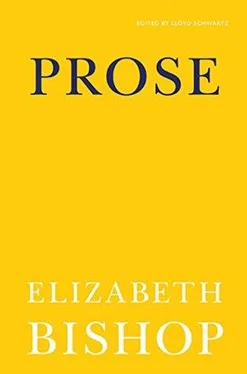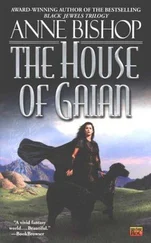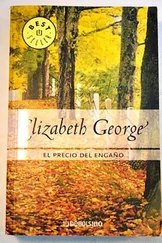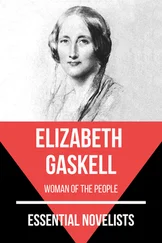His house was a real Cuban house, very bare, very clean, with a bicycle standing in the narrow front hall. The living room had a doorway draped with green chenille Christmas fringe, and six straight chairs around a little table in the middle bearing a bunch of artificial flowers. The bareness of a Cuban house, and the apparent remoteness of every object in it from every other object, gives one the same sensation as the bareness and remoteness of Gregorio’s best pictures. The only decorations I remember seeing in the house were the crochet- and embroidery-work being done by one of the daughters, which was always on the table in the living room, and a few photographs, — of Gregorio when he had played the trombone in a band as a young man, a wedding party, etc., and a marriage certificate, hanging on the walls. Also in the hall there was a wonderful clock. The case was a plaster statue, painted bronze, of President Roosevelt manipulating a ship’s wheel. On the face there was a picture of a barkeeper shaking cocktails, and the little tin shaker actually shook up and down with the ticking of the clock. I think this must have been won at one of the Bingo tents that are opened at Key West every winter.
Gregorio grew steadily worse during the spring. His own doctor happened to be in Cuba and he refused to have any other come to see him. His daughters said that when they begged him to have a doctor he told them that if one came he would “throw him away”.
A friend and I went to see him about the first of May. It was the first time he had failed to get up to see us and we realized that he was dangerously sick. The family took us to a little room next to the kitchen, about six feet wide, where he lay on a low cot-bed. The room was only large enough to hold the bed, a wardrobe, a little stand and a slop-jar, and the rented house was in such a bad state of repair that light came up through the big holes in the floor. Gregorio, terribly emaciated, lay in bed wearing a blue shirt; his head was on a flat pillow, and just above him a little holy picture was tacked to the wall. He looked like one of those Mexican retablo paintings of miraculous cures, only in his case we were afraid no miraculous cure was possible.
That day we bought one of the few pictures he had on hand, — a still life of Key West fruits such as a cocoanut, a mango, sapodillos, a watermelon, and a sugar apple, all stiffly arranged against a blue background. In this picture the paint had cracked slightly, and examining it I discovered one eccentricity of Gregorio’s painting. The blue background extended all the way to the table top and where the paint had cracked the blue showed through the fruit. Apparently he had felt that since the wall was back of the fruit he should paint it there, before he could go on and paint the fruit in front of it.
The next day we discovered in the Sunday New York Times that he had a group of fifteen paintings on exhibition at the Artists’ Gallery in New York. We cut out the notice and took it to his house, but he was so sick he could only lie in bed holding out his thin arms and saying “Excuse, excuse”. We were relieved, however, when the family told us that he had at last consented to have another doctor come to see him.
On the evening of the ninth of May we were extremely shocked when a Cuban friend we met on the street told us that “Gregorio died at five o’clock”. We drove to the house right away. Several people were standing on the verandah in the dark, talking in low voices. One young man came up and said to us, “The old man die at five o’clock”. He did not mean to be disrespectful but his English was poor and he said “old man” instead of “father”.
The funeral took place the next afternoon. Only relatives and close friends attend the service of a Cuban funeral and only men go to the cemetery, so there were a great many cars drawn up in front of the house filled with the waiting men. Very quickly the coffin was carried out, covered with the pale, loose Rock Roses that the Valdes grow for sale in their back yard. Afterwards we were invited in, “to see the children”.
Gregorio was so small and had such a detached manner that it was always surprising to think of him as a patriarch. He had five daughters and two sons: Jennie, Gregorio, Florencio, Anna Louisa, Carmela, Adela and Estella. Two of the daughters are married and he had three grandchildren, two boys and a girl.
I had been afraid that when I brought him the clipping from the Times he had been too sick to understand it, but the youngest daughter told me that he had looked at it a great deal and had kept telling them all that he was “going to get the first prize for painting in New York”.
She told me several other anecdotes about her father, — how when the battleships came into Key West harbor during the war he had made a large scale model of one of them, exact in every detail, and had used it as an ice-cream cart, to peddle Cuban ices through the streets. It attracted the attention of a tourist from the north and he bought it, “for eighty dollars”. She said that when the carnivals came to town he would sit up all night by the light of an oil lamp, making little pin-wheels to sell. He used to spend many nights at his studio, too, when he wanted to finish a sign or a picture, getting a little sleep on the cot there.
He had learned to paint when he and his wife were “sweethearts,” she said, from an old man they call a name that sounds like “Musi”,—no one knows how to spell it or remembers his real name. This old man lived in a house belonging to the Valdes, but he was too poor to pay rent and so he gave Gregorio painting lessons instead.
Gregorio had worked in the cigar factories, been a sign painter, an ice-cream peddler, and for a short time a photographer, in the effort to support his large family. He made several trips to Cuba and twenty years ago worked for a while in the cigar factories in Tampa, returning to Key West because his wife liked it better. While in Tampa he painted signs as well, and also the sides of delivery wagons. There are some of his signs in Key West, — a large one for the Sociedad de Cuba and one for a grocery store, especially, have certain of the qualities of his pictures. Just down the street from his house, opposite the Sociedad de Cuba, there used to be a little café for the workers in a near-by cigar factory, the Forget-Me-Not Café, Café no me Olvidades. Ten years ago or so Gregorio painted a picture of it on the wall of the café itself, with the blue sky, the telephone pole and wires, and the name, all very exact. Mr. Rafael Rodriguez, the former owner who showed it to us, seemed to feel rather badly because since the cigar factory and the café have both disappeared, the color of the doors and window frames has been changed from blue to orange, making Gregorio’s picture no longer as perfect as it was.
This story is told by Mr. Edwin Denby in his article on Valdes for the Artists’ Gallery exhibition: “When he was a young man he lived with an uncle. One day when that uncle was at work, Valdes took down the towel rack that hung next to the wash-basin and put up instead a painting of the rack with the towel on it. When the uncle came back at five, he went to the basin, bent over and washed his face hard; and still bent over he reached up for the towel. But he couldn’t get hold. With the water streaming into his eyes, he squinted up at it, saw it and clawed at it, but the towel wouldn’t come off the wall. ‘Me laugh plenty, plenty,’ Valdes said.…”
This classical ideal of verisimilitude did not always succeed so well, fortunately. Gregorio was not a great painter at all, and although he certainly belongs to the class of painters we call “primitive”, sometimes he was not even a good “primitive”. His pictures are of uneven quality. They are almost all copies of photographs or of reproductions of other pictures. Usually when he copied from such reproductions he succeeded in nothing more than the worst sort of “calendar” painting, and again when he copied, particularly from a photograph, and particularly from a photograph of something he knew and liked, such as palm trees, he managed to make just the right changes in perspective and coloring to give it a peculiar and captivating freshness, flatness, and remoteness. But Gregorio himself did not see any difference between what we think of as his good pictures and his poor pictures, and his painting a good one or a bad one seems to have been entirely a matter of luck.
Читать дальше












